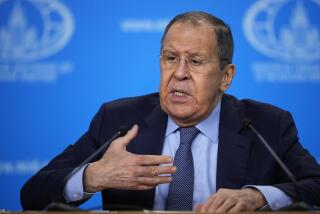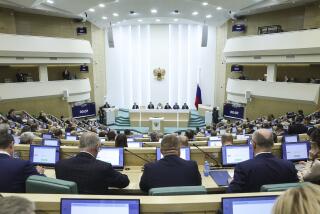Next: Strategic Nukes for Numbers Control
The Geneva arms-control talks, like the U.S. nuclear deterrent, consist of a triad. Critics prefer to characterize these talks as a three-ring circus.
The Moscow meeting between Secretary of State George P. Shultz and Soviet Foreign Minister Eduard A. Shevardnadze was supposed to wrap up details on a treaty eliminating intermediate-range nuclear missiles and set a summit date. The Kremlin now says, however, that a summit requires agreement on key provisions of a strategic-arms reduction treaty.
Until now, the START talks have been obscured by continuing superpower disputes over strategic defenses, but as a result of the Kremlin’s tactics, START is about to emerge from the shadows.
Although strategic nuclear forces dwarf those covered under the proposed INF agreement, the START negotiations have been a sideshow because of Moscow’s assertion that deep cuts must be directly linked to constraints on President Reagan’s Strategic Defense Initiative.
Two factors have completely changed the pace and prospects of the Geneva talks. One is the emergence of Mikhail S. Gorbachev as an imaginative leader able to pursue traditional Soviet political objectives through unconventional means. The other is Ronald Reagan’s apparent desire to leave something more substantial than the national debt as his legacy to history.
Despite the Kremlin’s latest ploy to retie an INF treaty to “Star Wars” testing, an accord will probably be reached. Gorbachev hopes to weaken Western political and military cohesion by giving up a favorable balance of nuclear forces. Reagan wants to bask in the authorship of the first arms-reduction agreement of the nuclear era. Many have challenged the Administration’s judgment in accepting a deal that creates political and military problems for the North Atlantic Treaty Organization but the President was in no position to reject his own zero option after Gorbachev publicly advanced the U.S. negotiating position.
The Senate will address the military wisdom of the INF agreement in the ratification process, but it can only weaken the U.S. image in Europe if it reneges on the deal or sets new conditions for implementation that NATO is unlikely to meet.
Attention must now focus on what might follow. If Gorbachev is serious about channeling resources from the military into the civilian sector of the Soviet economy, he must move beyond nuclear arms reductions to cuts in conventional forces (please see article below).
Well before the conventional discussions gain momentum, however, the Kremlin wants to to pick up the pace in START, as well negotiating constraints on SDI--in part by reaffirming U.S. commitments to the Anti-Ballistic Missile Treaty.
As a sweetener, Gorbachev has indicated that significant progress in START is possible even if the United States continues research--including research in space--on SDI. Moscow is probably banking on budgetary and technical constraints to impede progress on SDI--and on the Democratic majority in Congress to prevent early deployments and tests that do not conform to the “traditional” interpretation of the ABM Treaty. As evidenced by the Moscow meeting, the Soviets are alternating between tightening and relaxing the SDI-START linkage.
A speed-up in START negotiations would stimulate a long overdue appraisal of the implications of deep cuts on U.S. and Soviet strategic forces. The ceilings of 6,000 deployed warheads and 1,600 launchers agreed to at Reykjavik do not constitute the advertised 50% reductions. Nonetheless, they call for deeper cuts than anything contemplated in the SALT decade of negotiations. For example, the United States has long relied on a force of approximately 40 missile-carrying submarines. Under a START agreement, this force could easily drop to 16 boats, mainly because each Trident submarine contains a larger number of missiles than the Poseidon boats it will replace.
A sharp reduction in the most secure leg of the U.S. strategic triad could easily invite a reprise of the “window of vulnerability” debate that plagued the Carter Administration. While the Kremlin has agreed to a 50% reduction in its most threatening missiles, the SS-18s, it could still retain 1,540 of these warheads--a larger number than the total U.S. missiles, subs and bombers likely to be deployed under a START agreement.
One way to improve the survivability of smaller levels of strategic forces is to increase their mobility. The Kremlin has already begun taking appropriate action; it has started deploying two new mobile land-based missiles. In contrast, the Reagan Administration and Congress have been unable to agree either on the deployment of new land-based missiles or their basing modes.
The current U.S. START proposal opts for improved targeting instead of improved survivability by banning mobile missiles. Since the logic behind the Reagan Administration’s offer cannot withstand intellectual scrutiny and since the Soviets have already made it obsolete, the ban on mobiles will no doubt be dropped as the negotiations proceed. That places the burden on the Soviets to simplify verification of their mobile missiles, and on the United States either to improve the survivability of land-based missiles or compensate for the lack of mobility.
Aside from differences over banning mobiles and handling sea-launched cruise missiles, American strategic forces could look the same under either the Soviet or the U.S. START proposal now on the table. In contrast, the two proposals have markedly different impacts on the Kremlin’s forces. The Soviets’ proposal allows them to deploy approximately 2,000 warheads on their two new mobile missiles--the 10-warhead SS-24 and the single warhead SS-25--in addition to retaining one-half of their SS-18 missile force. The Reagan Administration’s proposal would force the Soviets to choose between future deployments of SS-18s and SS-24s by means of a sub-limit on silo-based missiles carrying more than six warheads.
The Soviets argue that the Reagan Administration is trying to dictate their force structure. The Administration contends that the Soviets are seeking strategic advantage by means of prompt counterforce weapons. Each concern is strongly held, and the Soviet force of SS-18 missiles lies at the heart of both. Even 50% reductions in this missile force may still not allay concerns about Moscow’s nuclear war-fighting potential, since the remaining SS-18s can theoretically cover the shrunken set of U.S. strategic forces under START. The Reagan Administration’s push for missile sub-limits therefore is based on sound logic, unlike its attempt to ban mobiles. The Soviets could ease these legitimate concerns and help create a stable strategic balance at much lower levels by cutting their SS-18 force beyond 50%; the Reagan Administration could then alleviate Soviet concerns about force restructuring by lifting or removing sub-limits.
Soviet officials argue that it is unfair to focus on their land-based missiles when Trident submarines will eventually acquire similar counterforce capabilities. This is true, but it is also likely to be true for Soviet sea-based forces unless both sides take steps to stop it. Moreover, sea-based forces do not lend themselves to surprise attack scenarios unless the attacker operates close to targets where he will be most susceptible to detection and anti-submarine warfare. Finally, the command and control problems associated with preemptive strikes by sea-based forces are far greater than for land-based missiles.
The Kremlin is unlikely to cut much deeper into its SS-18 force unless its concerns about the prospective increase in U.S. counterforce capabilities are taken into account. One way of addressing these concerns would be to establish exclusion zones for sea-launched ballistic and cruise missile platforms in adjacent waters.
Arguments over a prospective START agreement, as well as SDI, will no doubt intensify as a result of the meeting between Shultz and Shevardnadze. SDI remains the more intractable of the two issues. Gorbachev can enhance the prospects of compromise, however, by accelerating progress in START. The deeper both sides cut into their strategic forces, the more careful they will have to be in choosing the forces that are retained. Understanding the implications of current proposals is a necessary first step in choosing wisely.
More to Read
Start your day right
Sign up for Essential California for news, features and recommendations from the L.A. Times and beyond in your inbox six days a week.
You may occasionally receive promotional content from the Los Angeles Times.






